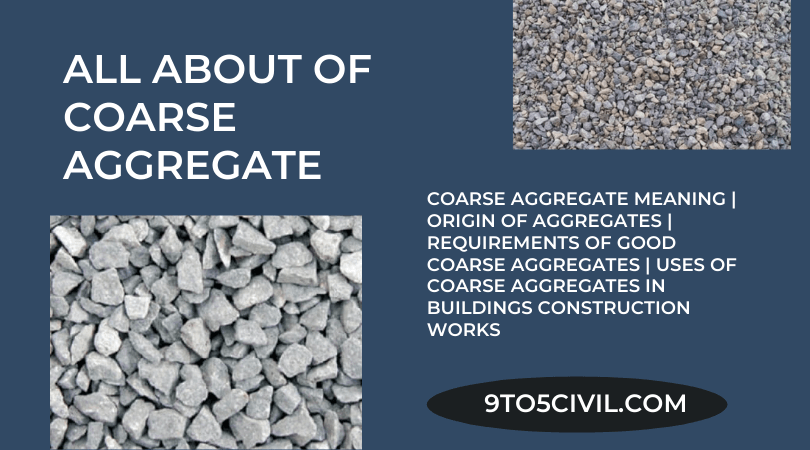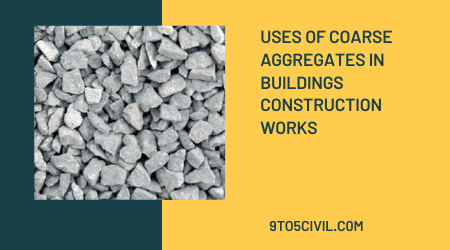Introduction of Coarse Aggregate
Sand and stone have been used for foundations in construction for thousands of years. Aggregate was used during the Roman Empire to build a vast network of roads. After the invention of concrete, the aggregate was used in high-rise buildings.
aggregate performs the most important function in concrete. The aggregate gives strength and volume to concrete.
Coarse Aggregate is used for a variety of purposes in each construction project. For example, aggregate can be used on roads, buildings, and railway tracks.
Coarse aggregate is the building material used as the main component for concrete in the construction industry.
Coarse aggregate in concrete gives stability and strength to concrete. In addition, coarse aggregate in concrete gives a uniform mass of concrete as the filling material.
Coarse Aggregate Meaning
Concrete usually consists of coarse aggregate with aggregate retained on a sieve of 4.75 mm. The coarse aggregate varies in size for road pavement in different conditions. Coarse aggregate occupies 75% of the space in concrete.
Origin of Aggregates
Coarse aggregate is mainly produced from quarries by undergoing various processes like blasting, crushing, and sieving.
The strength of aggregate depends on the quality and type of rock. Examples of rocks include sedimentary rocks, igneous rocks, metamorphic rocks, etc.
Also Read : What Is MDF? | MDF Board Uses | MDF Board Properties | Application of MDF Board |
Requirements of Good Coarse Aggregates
Coarse aggregate must have some of the following requirements for use in construction.
- Coarse aggregate in concrete used for construction should be free from any decomposing fragments, vegetable impurities, alkalis, etc.
- The coarse aggregate used for concrete should not have soft and highly porous properties.
- The coarse aggregate used for concrete should absorb less than 5% of water.
- The coarse aggregate used for concrete should be cubical or spherical, or angular in shape.
- The coarse aggregate used for concrete should be made of strong and durable rock.
- Coarse aggregate for concrete should be able to retain its properties during chemical processing.
- The ideal size of coarse aggregate should be as follows. The coarse aggregate should pass through an IS 63 mm sieve and retain on a 4.75 mm IS sieve.
Also Read : What Is Kitchen Layout? | Type of Kitchen Layout | Advantage & Disadvantage of Kitchen Layout
Uses of Coarse Aggregates in Buildings Construction Works
In the construction industry, Coarse aggregate is used considering the strength and design of the concrete.
Coarse Aggregate is used in a variety of ways in the construction industry as needed. The coarse aggregate is used to resist the load coming from the concrete structure of the construction and to distribute the load properly in the ground to the foundation.
Coarse aggregate plays an important role in sewage treatment processes and water filtration.
Coarse aggregate is widely used in construction due to its various properties like abrasion resistance, hardness, elastic modulus, etc. coarse aggregate can be used in applications other than construction. For example, Coarse aggregate can be used in the backfill, filling, drainage, and filtration work.
Also Read : What Is Culvert? | Meterial for Culvert | Types of Culverts | Advantages of Culverts
Coarse aggregates can be used primarily as a base for heavy roadways.
Coarse aggregate is used as material in construction as follows,
- As for filling material
- As bearing material
- As infiltration material
Uses of Coarse Aggregates for Roads
- Coarse aggregate is used for road pavement for different size coarse aggregate as a required base, sub-base.
- Different layers of coarse aggregate are used to increase the stability of the road pavement.
- The use of coarse aggregate with bituminous material in road pavement provides a strong bond.
- Recycled Coarse Aggregates can also be used for road pavement.
- For roads should, coarse aggregate is used to block the flow of rainwater from the surface.
Uses of Aggregate In Concrete
- Coarse aggregate is one of the most important components in concrete, which has a size of 75% in concrete.
- Coarse Aggregates are used to provide a rigid structure for a concrete frame structure.
- coarse aggregate helps reduce shrinkage in concrete and cracks in concrete.
- Coarse aggregate is used in concrete to make heavy structures as for example, high-rise buildings, bridges, foundations, etc.
- The use of coarse aggregate and fine aggregate in concrete can enable it to withstand the external environment.
Classification Of Coarse Aggregates
(A). Classification of the Aggregates: source or the nature of the formation of the aggregate.
- Naturally Occurring Aggregates.
- Artificially Manufactured Aggregates.
1. Naturally Occurring Aggregates-
Coarse aggregates are usually obtained by stone quarries and stone crushers. Natural aggregate is naturally produced by the digging of bedrock.
2. Artificially Manufactured Aggregates-
Artificial aggregates material such as broken bricks or blast furnace slag is used as aggregate. Artificial aggregates can also be used for various concreting work such as PCC work.
(B) Classification Of Coarse Aggregate: Shape
The shape of the coarse aggregate has a significant effect on the efficiency of the concrete. The different shapes of coarse aggregates are as follows.
1. Angular Aggregates
The angular aggregate gives less efficiency in concrete. But angular aggregate is used for high-strength concrete. Angular aggregate connects properly with fine aggregate in concrete. As a result, less void remains in the concrete.
2. Elongated Aggregates
In this type of coarse aggregate, the length of the particle is greater than its width. Therefore in this type of coarse aggregate, the concrete gives less compressive strength. Thus, the use of this type of Coarse aggregate should be avoided in building construction.
If this type of Coarse aggregate is used in concrete, the concrete remains highly void. Which reduces the strength and durability of concrete.
3. Rounded Aggregates
Rounded aggregates are usually found in seashore or riverbank areas. This type of coarse aggregate provides high efficiency in concrete. But this type of coarse aggregate has poor quality in interlocking with each other. Therefore, it is not used for high-strength concrete structures.
Generally, this type of coarse aggregate can be used as PCC and filling material.
Also Read : What Is Salt Finish Concrete? | Specification of Salt Finish Concrete | Process of Salt Finish Concrete
4. Irregular Aggregates
The compressive strength of concrete of irregular aggregates is less than that of angular aggregates.
This type of coarse aggregate, due to its irregular shape, gives low bonding strength in concrete with fine aggregate. In addition, this type of coarse aggregate has low efficiency of concrete.
5. Flaky Aggregates
The thickness of this type of coarse aggregate is 60% less than its average size. It is called flaky aggregate. This type of coarse aggregate has low workability in concrete.
The use of this type of coarse aggregate gives the concrete low strength and durability.
6. Flaky & Elongated Aggregates
The use of flaky and elongated aggregate in concrete results in low workability and durability of concrete. The use of this type of coarse aggregate in concrete reduces the strength of concrete.
Properties of Coarse Aggregates
Coarse aggregate is widely used in construction in various elements. So we should know the properties of coarse aggregate.
The properties of coarse aggregate are explained in detail as follows.
1.Properties of Coarse Aggregates: Shape
The shape of coarse aggregate is one of the most important properties of concrete. The shape of the coarse aggregate affects the efficiency of the concrete. In addition, the shape of the coarse aggregates also affects the binding strength of the concrete nay components to each other.
In general, angular and irregular shapes as coarse aggregate in concrete give good strength. Particles of this type of coarse aggregate get stronger by joining with each other in concrete.
2. Properties of Coarse Aggregates: Size
The size of coarse aggregate is used for concrete in construction as per the requirement of concrete. Large Coarse aggregate sizes of 80 mm, 40 mm and 20 mm are used for mass concrete.
A 20 mm size of coarse agagregate is usually used for the construction of a residential building.
3. Properties of Coarse Aggregates: Water Absorption
Water absorption in coarse agregate as a component of concrete is considered to be a very important property.
If the coarse aggregate absorbs water, the worability of the concrete decreases. And the need for concrete also decreases in strength.
Water absorption depends on the porosity of the coarse aggregate. So that more water is required for the workability of concrete. So as to affect the durability of the concrete.
4. Properties of Coarse Aggregates: Soundness
The soundness of coarse aggregate can be expressed as resistance. Which represents a change in any type of volume caused by a coarse aggregate.
Porous coarse aggregates give less strength in concrete.Coarse aggregate used in concrete as foundation is used after soundness test.
5. Properties of Coarse Aggregates: Surface Texture
Coarse aggregate surface texture Roughness and smoothness affect the strength of concrete.
Coarse aggregate with rough surface gives good bonding in concrete. Therefore, coarse aggregate with such rough surface is preferred for concrete. But coarse aggregate with rough surface has less workability.
Coarse aggregate with a smooth surface like a rounded coarse aggregate has good workability in concrete. It creates very weak bonding in concrete.
6. Properties of Coarse Aggregates: Specific Gravity
Specific gravity is expressed as the ratio of the weight of coarse aggregate to the total dry weight of coarse aggregate in the same amount of water.
The specific gravity for the use of Coarse agagregate in construction is generally acceptable, between 2.5 and 3.0 range.
7. Properties of Coarse Aggregates: Bulk Density
The bulk density of the coarse aggregate is expressed as the ratio of the net weight of the coarse aggregate.
Grading of Coarse Aggregate:
- Coarse aggregate grading is the art of distributing coarse aggregate in different sizes.
- The grading of coarse aggregate is done for concrete used for various needs in construction. coarse aggregate grading affects the efficiency, strength, and durability of concrete.
- Proper grading of coarse aggregate is required for the quality of concrete for building.
- The coarse aggregate is graded to achieve the proper efficiency of concrete.
Like this post? Share it with your friends!
Suggested Read –
- What Are Hollow Bricks? | Advantage of Hollow Brick | Disadvantage of Hollow Bricks | Sizes of Hollow Bricks | How to Make Hollow Bricks? | Hollow Bricks Properties | Uses of Hollow Bricks
- Difference Between One Way Slab and Two Way Slab | What Is Slab? | What Is One-Way Slab? | What Is Two Way Slab? | What Is Flat Slab? | What Is Grid Slab?
- What Is Seasoning of Timber? | Objectives of Seasoning of Timber | Types of Timber Seasoning | Advantages & Disadvantages of Natural Seasoning of Timber | Advantages & Disadvantages of Artificial Seasoning of Timber
- What Is Rat Trap Bond? | Construction of Rat Trap Bond | Material Selection for Rat Trap Bond in Masonary Work | Advantages & Disadvantages of Rat Trap Bond in Masonry Work
- What Is Space Frame? | Components of Space Frame System | Types of Space Frame | Space Frame Structures Examples | Advantages &Disadvantages of Space Frame Structure
 Skip to content
Skip to content


